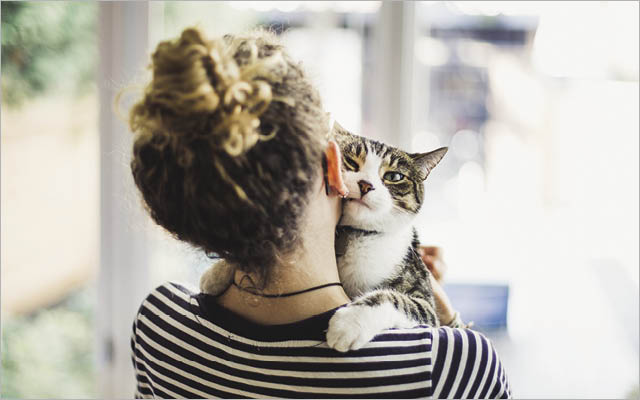Often, pets are our best barometers, reflecting our mental and physical state of being. My dog Zaela, for example, is my daily gauge. If you want to know how I’m feeling today, just look at my ever-present four-legged companion. When Zaela is grinning and wagging her tail, you can be pretty sure I’m in a good mood. A forlorn, listless Zaela, however, may indicate that it’s not the best day to approach me for a raise.
But it’s not just our mood that gets reflected by our pets. Our entire rhythm and quality of life determines theirs. And the repercussions of our tendencies toward overwork are no exception.
Long hours spent at the office don’t just negatively impact our own life satisfaction, they also directly affect the health and happiness of our animal companions. When we’re short of time, energy and attention, or just plain never home, our pets pay the price. Chronic neglect of our pets’ emotional and physical needs can result in their developing behavioral and physical abnormalities, including obesity, diabetes, separation anxiety and other maladaptive disorders.
I have witnessed this phenomenon in my own home. One morning, while groggily brushing my teeth, I nearly stepped on a large brown “surprise” that had been neatly deposited in the center of the bath mat by my housemate’s cat, Echo.
OK, I thought, no big deal; cats occasionally have accidents in the wrong place. But when little brown “surprises” reappeared in the same spot each morning for a week, I knew something was amiss. Echo was trying to say something, and was in fact “echoing” my housemate’s current stress over her job and relationship. Ann, wrapped up in her own distress, had been oblivious to her cat – too distracted to pay her any mind. Once Ann was able to step outside herself and spend more time with Echo, the problem ended.
The Care Cure
While Ann’s response to her cat’s abnormal behavior was to pay her more attention, a growing number of Americans are choosing quick fixes to deal with stressed-out pets. Dogs suffering from separation anxiety are pumped full of Prozac-like antidepressants or, worse, dumped at the local animal shelter by guardians who believe the behavior irremediable. A reported 20 to 40 percent of pets, primarily dogs, suffer from separation anxiety. Canine separation anxiety, today’s No. 1 doggie behavioral problem, has been linked to absentee caretakers.
Obesity in pets is another reflection of a society deeply out of kilter. Thirty to 40 percent of pets brought to veterinary clinics today are obese. A serious medical problem, obesity has been linked to poor diet, lack of exercise and anxiety-based overeating. Overweight dogs are more at risk in surgery, more prone to injury, and have more stress on their hearts, lungs, livers, kidneys and joints. As in people, obesity can lead to diabetes and heart disease in dogs and cats.
Stand-Ins and Sitters
Is it fair that our companion animals suffer physically and emotionally because we don’t make time for them? Clearly, many feel that it isn’t right. Some guilt-ridden, overworked, pressed-for-time humans find relief in the burgeoning pet-sitting business.
Pet sitting is one of the fastest-growing sectors of the pet-service industry (and in some upscale locales, the fastest-growing business around). Two national professional associations, Pet Sitters International and the National Association of Professional Pet Sitters, boast a combined membership of 8,400. Services offered for canines range from dog walking and feeding to full-time doggie daycare, complete with play groups, snacks, leash walks and snuggle time.
Mechanized gadgets for pets are also taking the place of time-stressed humans. The billion-dollar pet-supply industry has produced an array of toys (costing as much as $500 each) that don’t require the presence of humans at all. Hawking everything from mechanized tennis-ball throwers to voice-activated “Talk to Me Treatballs” and mouse-shaped machines that whip pieces of string around for hours, the toymakers are taking advantage of guilt-ridden dog and cat guardians. Animal caretakers spend more than $30 billion each year on their beloved companions, more than is spent annually on toys for children.
While it’s perhaps refreshing that people care enough for their companion animals to lavish money on them, the increase in services and supplies that attempt to replace the animal-human bond is a disturbing trend – one that may indicate a deeper systemic imbalance within our society. Western civilization’s overemphasis on work and productivity has led to a diminution of social interaction, and unfortunately humans are not the only species that suffer as a result.
Pet Therapeutics
Amid all the disturbing trends, however, there is also reason for hope. While many Americans have left Fluffy and Fido in the lurch, others are discovering the benefits of spending time with nonhuman animals. “Pet-assisted therapy” has gained increasing attention in recent years for a wide variety of human patients, including people with AIDS or cancer, the elderly, and the mentally ill. Stroking a dog, watching a kitten play or observing the hypnotic explorations of fish can reduce stress and loneliness, lower blood pressure, and shift our focus beyond ourselves, helping us connect to a larger world.
Animals can evoke people’s nurturing instinct. They make us feel safe, and they provide unconditional, nonjudgmental love and affection. In nursing homes, animals are known to boost people’s moods and enhance their social interaction. Research shows that heart-attack victims who have companion animals live longer, in part, because they may feel needed and responsible, which can stimulate their survival instinct.
Companion animals may actually help prevent human illness and disease. A 1990 study of 1,000 Medicare patients revealed that people with dogs visited their doctors 16 percent less often than those who didn’t have a dog. A UCLA study found that people with dogs required much less medical care for stress-induced aches and pains than those without a canine companion. A 1991 study published in the Journal of the Royal Society of Medicine (1991, Vol. 84) confirmed these findings, demonstrating that over a 10-month period, dog guardians had fewer small-scale health problems and took more and longer walks than people without dogs.
Coming Back to Our Companions
Must it take illness or old age for us to recognize the mental and physical benefits we gain from slowing down and interacting with our animal friends? Imagine if the 63 million households with companion animals were all to stop what they’re doing at this very moment – get out of their SUVs, hang up their cell phones, unplug their laptops and TVs – and spend the next hour interacting with their dogs, cats, parrots or fish.
Imagine how many hearts would relax, how many foul moods would cheer up, how many uptight, pressed-for-time bosses would lighten up, and how many smiles and laughs would erupt. Wouldn’t it be a sight to behold?
Of course, one hour here and there is not enough. Ultimately, we must recognize that providing a lifetime of adequate care and attention to our furred, feathered and finned friends may require changing our habits and behavior. We may need to seek out innovative ways to spend more time with our companion animals. A few ideas:
- Use your pet’s very real needs as a good reason to get home at a reasonable time.
- Encourage your workplace to adopt more pet-friendly policies, including “bring your pet to work” days.
- Establish shared companion-animal-care arrangements with friends, family or neighbors.
- Turn off your TV and other inanimate entertainment devices and spend more downtime actively enjoying your animal friends.
In our overworked, rush-rush society, our pets are too often silent losers. So the next time Fido sits pleadingly at your feet while your nose is in your laptop, see it as a sign. Turn off the computer, put aside your personal and professional problems, and spend some quality time with your pet. You’ll be surprised at what this interaction can do for your mind, body and spirit – and for your furry friend.
This article was adapted from the book Take Back Your Time: Fighting Overwork and Time Poverty in America, edited by John de Graaf, and appears by permission of the publisher.




This Post Has 0 Comments